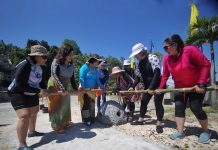By GregORIO G. Deligero
Even as Davao City is known as a typhoon-free area, the city is not completely free from the occurrence of extreme weather events attributed to climate change such as flooding, sea level rise, strong winds, rain-induced landslides, monsoon waves and drought.
In a presentation during the opening yesterday of the two-day high-level consultation for local climate change actions, city planning and development coordinator Mario Luis J. Jacinto said that based on the Vulnerability and Adaptation Assessment (VAA) in Davao City, the city is most vulnerable to flooding.
He said the occurrence of flooding stemmed from the increase of rainfall volume, new developments in previously undisturbed watershed areas, the encroachment of informal settlers to riverbanks and protected areas and the clogged and inadequate drainage.
Another factor that exacerbates the city’s vulnerability to flooding is the occurrence of sea level rise.
“We have 60 kilometers of coastline and the vulnerability of these areas to flooding is practically high during heavy rains,” Jacinto said.
The VAA report said the rise in sea levels has been observed in Davao City as water elevation in major storm drain outfalls to the Davao Gulf is now higher than the drainage lines, usually causing inundation in low lying areas particularly when heavy rains occur during high tide.
“Out of 16 major outfalls, 87.5 % or 14 of which are directed to Davao Gulf. The invert elevation of major storm drains outfalls to the gulf are at mean sea level or lower, thus, discharge capacities depend on the tide level. This explains the high risk of coastal inundation to almost 21 barangays in the Central Business District (CBD) with an estimated total of 2,370 families,” it said.
The VAA report also attributed the clogging of water channels and drainage systems to improper solid waste disposal with the informal settlement families being a major contributor.
The report said that the changing water course expands the width of rivers, creating deltas, boulders and islets can lead to flooding in areas not flooded before.
“Flooding in urban areas as a result of continuous heavy downpour and coastal inundation due to sea level rise poses a huge threat in the CBD,” it said.
According to the VAA report, around 550 hectares of low lying land area in the city’s CBD are usually affected by flooding after thirty minutes of heavy rain. “Inadequate drainage system associated with improper waste disposal has contributed to this impact,” it said.
Davao City has seven major rivers and six of which usually overflow during or after three to five of heavy rains in the upland areas.
“The rise in sea level and the frequent incidences of flooding in the CBD will result to disruption of urban mobility. About 198 kilometers of road are located in flood prone areas in 32 barangays. Flooded street leads to traffic congestion, thus delivery of perishable goods and commodities as well as access to commercial establishments and other facilities are affected,” it said.
Aside from ensuring that all natural waterways are clear of obstruction, Jacinto said the city’s adaptation options include the implementation of climate change monitoring program to enhance our capacity to monitor sea-level in the city and the beach reforestation project to minimize saltwater intrusion.
“We will disseminate information and make our communities aware of it, provide them with livelihoods and strictly enforce our laws. We make sure that there will be no obstruction in our waterways and construct drainage lines. We have to improve vegetation in watersheds to reduce siltation,” he said.
“Our adaptation initiatives will be a continuing effort. It will always be a work in progress as we continue to improve in building sustainable communities,” Jacinto said.
0 Comments
Oldest





